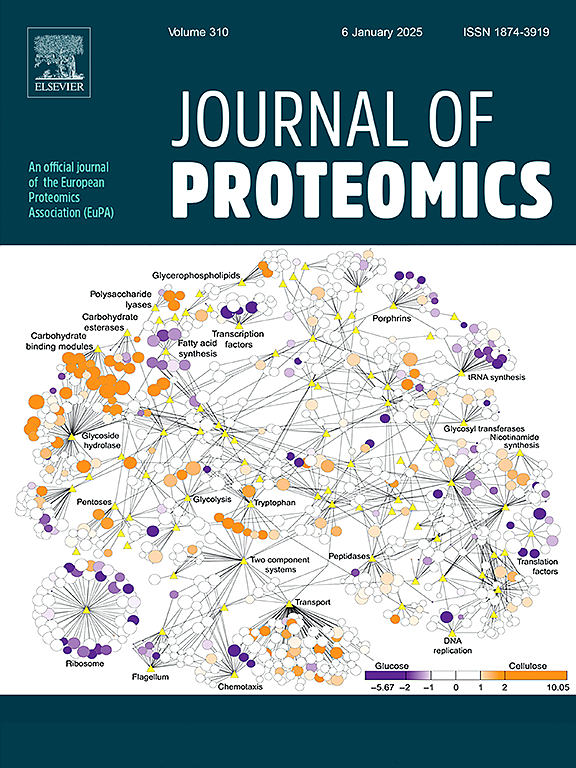氧化还原蛋白质组学工作流程揭示血管内皮细胞氧化的细胞外目标。
IF 2.8
2区 生物学
Q2 BIOCHEMICAL RESEARCH METHODS
引用次数: 0
摘要
氧化还原调控已成为细胞信号传导的关键过程。细胞外细胞表面氧化还原敏感蛋白在氧化还原调节和细胞内通讯中的作用已被氧化还原酶的分泌所支持,氧化还原酶调节巯基二硫开关。尽管取得了这些进展,细胞表面的氧化还原敏感靶点仍然很少被探索。我们建立了一个全面的氧化还原蛋白质组学工作流程,使用质膜不渗透硫醇标记,我们鉴定了1159个易氧化的细胞表面和细胞外蛋白质。与对照组相比,二胺或尿酸氢过氧化物(HOOU)处理导致377和12个氧化还原调节蛋白差异丰富。这些蛋白包括伴侣蛋白、粘附分子、囊泡相关蛋白、通道、受体、细胞骨架等,可能在多种信号通路中发挥相关作用。二胺对11种氧化还原酶进行了氧化还原调节,包括蛋白二硫异构酶(PDI)、过氧化物还蛋白(PRDX)和quiescin巯基氧化酶(QSOX)家族的成员,特别关注PDI TMX3 (TMX3),这提供了其在内皮细胞中分泌的第一个证据。总之,我们的发现不仅揭示了细胞表面潜在的氧化还原敏感靶点,而且为未来的研究提供了一个有用的工具,旨在分析不同生物背景下细胞外环境中的氧化还原调控。意义:细胞表面的氧化还原信号正在成为血管功能的重要调节因子,强调其在心血管疾病中的作用。然而,由于方法的复杂性,细胞外氧化还原蛋白质组仍未得到充分研究。我们开发了一种可重复的工作流程,结合差分硫醇标记和质谱法,系统地绘制暴露于氧化剂的内皮细胞中氧化的细胞外蛋白。数百种蛋白质被确定为氧化还原敏感靶标。关键官能团包括分子伴侣、粘附分子、囊泡相关蛋白、通道、受体和细胞骨架。这项工作揭示了对细胞外氧化还原调控的新见解,扩展了已知氧化还原敏感蛋白的库,并建立了一个多功能平台来研究血管生物学和其他病理生理背景下细胞表面的氧化还原动力学。本文章由计算机程序翻译,如有差异,请以英文原文为准。

Redox proteomics workflow to unveil extracellular targets of oxidation in vascular endothelial cells
Redox regulation has emerged as a key process in cellular signaling. The role of extracellular cell surface redox-sensitive proteins in redox regulation and intracellular communication has been supported by secretion of oxidoreductases that modulate thiol-disulfide switches. Despite these advances, redox-sensitive targets on the cell surface remain little explored. We established a comprehensive redox proteomic workflow using plasma membrane impermeable thiol labeling where we identified 1159 cell surface and extracellular proteins susceptible to oxidation. Treatment with diamide or urate hydroperoxide (HOOU) resulted in 377 and 12 differentially abundant redox-modulated proteins compared to control. Such proteins represent chaperones, adhesion molecules, vesicle-associated proteins, channels, receptors, cytoskeleton, and others, which may play a relevant role in several signaling pathway. Eleven oxidoreductases were redox-modulated by diamide, including members of the protein disulfide isomerase (PDI), peroxiredoxin (PRDX), and quiescin sulfhydryl oxidase (QSOX) families, with a particular focus on PDI TMX3 (TMX3), which provides the first evidence of its secretion in endothelial cells. In conclusion, our findings not only revealed potential redox-sensitive targets on the cell surface but also offer a useful tool for future investigations aiming to analyze redox regulation in the extracellular environment across diverse biological contexts.
Significance
Redox signaling at the cell surface is emerging as a crucial regulator of vascular function, emphasizing its role in cardiovascular disease. However, the extracellular redox proteome remains underexplored because of the complexity of the method. We developed a reproducible workflow combining differential thiol labeling and mass spectrometry to systematically map oxidized extracellular proteins in endothelial cells exposed to oxidants. Hundreds of proteins were identified as redox-sensitive targets. Key functional groups included molecular chaperones, adhesion molecules, vesicle-associated proteins, channels, receptors, and cytoskeleton. This work reveals novel insights into extracellular redox regulation, expands the repertoire of known redox-sensitive proteins, and establishes a versatile platform to investigate redox dynamics at cell surface both in vascular biology and other pathophysiological contexts.
求助全文
通过发布文献求助,成功后即可免费获取论文全文。
去求助
来源期刊

Journal of proteomics
生物-生化研究方法
CiteScore
7.10
自引率
3.00%
发文量
227
审稿时长
73 days
期刊介绍:
Journal of Proteomics is aimed at protein scientists and analytical chemists in the field of proteomics, biomarker discovery, protein analytics, plant proteomics, microbial and animal proteomics, human studies, tissue imaging by mass spectrometry, non-conventional and non-model organism proteomics, and protein bioinformatics. The journal welcomes papers in new and upcoming areas such as metabolomics, genomics, systems biology, toxicogenomics, pharmacoproteomics.
Journal of Proteomics unifies both fundamental scientists and clinicians, and includes translational research. Suggestions for reviews, webinars and thematic issues are welcome.
 求助内容:
求助内容: 应助结果提醒方式:
应助结果提醒方式:


